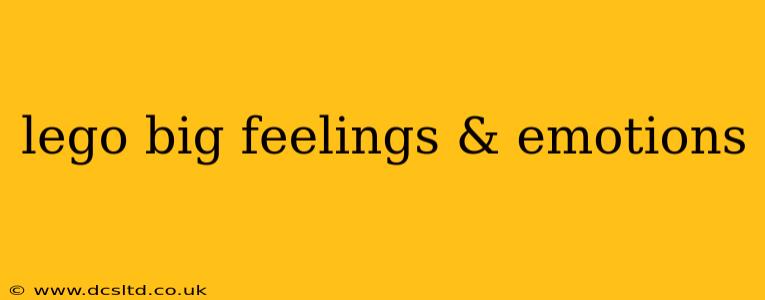LEGOs aren't just for building spaceships and castles; they're a powerful tool for exploring the complex world of emotions, especially for children. The LEGO Group's recent focus on social-emotional learning (SEL) through initiatives like the "LEGO Big Feelings" collection highlights the importance of playful learning in developing emotional intelligence. This isn't just about identifying emotions; it's about understanding, expressing, and managing them effectively. This post will delve into how LEGOs can help children (and even adults!) better understand and process their Big Feelings.
What are "Big Feelings" and Why are They Important?
"Big Feelings" are intense emotions that can sometimes feel overwhelming. These can include joy, anger, sadness, fear, frustration, excitement, and many others. Understanding and managing Big Feelings is crucial for healthy emotional development. Children who can identify and express their emotions are better equipped to navigate social situations, build healthy relationships, and develop resilience.
How Can LEGOs Help Kids Express Their Big Feelings?
LEGOs offer a unique avenue for emotional expression because they provide a non-threatening, creative outlet. Here's how:
-
Visual Representation: Children can build physical representations of their feelings. A towering, spiky creation might represent anger, while a soft, rounded structure could symbolize calmness. This visual representation makes abstract emotions more tangible and understandable.
-
Safe Space for Exploration: Building with LEGOs provides a safe space for children to explore their feelings without judgment. They can experiment with different building techniques to reflect their emotional state, allowing them to process complex emotions at their own pace.
-
Storytelling and Narrative: Children can use LEGOs to create stories and scenarios that reflect their feelings. A character overcoming a challenge might represent overcoming fear, while a joyful scene could depict happiness. This narrative approach helps them understand the context of their emotions.
-
Problem-Solving and Regulation: Building with LEGOs often involves problem-solving, a skill that translates directly to managing emotions. The act of planning, constructing, and adapting a build mirrors the process of navigating difficult emotional situations.
What are some specific LEGO activities to explore emotions?
There are countless ways to use LEGOs to explore emotions. Here are some ideas:
-
Feeling Faces: Build different faces representing various emotions, labeling each one clearly. This simple activity helps children associate specific facial expressions with emotions.
-
Emotion Building Challenge: Give children a prompt, such as "Build a LEGO creation that represents sadness," and let their creativity flow. Discuss their creations and the emotions they intended to portray.
-
Emotional Story Building: Have children build a scene that tells a story about experiencing and managing a particular emotion. This can be a powerful tool for working through challenging emotional experiences.
How can LEGOs help adults manage their Big Feelings?
The therapeutic benefits of LEGOs aren't limited to children. Adults can also use LEGOs as a creative outlet for stress relief and emotional processing. The focus and concentration required for building can be meditative, allowing for a break from the anxieties of daily life. Similarly, building can be a great way to de-stress after a long day.
Are there any specific LEGO sets designed for emotional learning?
While not explicitly labeled as such, many LEGO sets can be adapted for emotional learning. The emphasis should be on the creative process and self-expression, rather than adhering to specific instructions. The LEGO DUPLO line, designed for younger children, often incorporates themes that lend themselves well to exploring simple emotions.
How can I incorporate LEGOs into my child's emotional learning?
Start by simply providing LEGOs and encouraging free building. Ask open-ended questions like, "What are you building?" and "How does that make you feel?" Avoid judgment or criticism; focus on creating a safe and supportive environment for emotional exploration. You can gradually introduce more structured activities, such as the ones suggested above, as your child gains confidence.
In conclusion, LEGOs offer a versatile and engaging way to explore and manage Big Feelings. Through playful exploration, children and adults alike can develop a greater understanding of their emotions and build essential skills for emotional well-being. The possibilities are as limitless as the LEGO bricks themselves.
